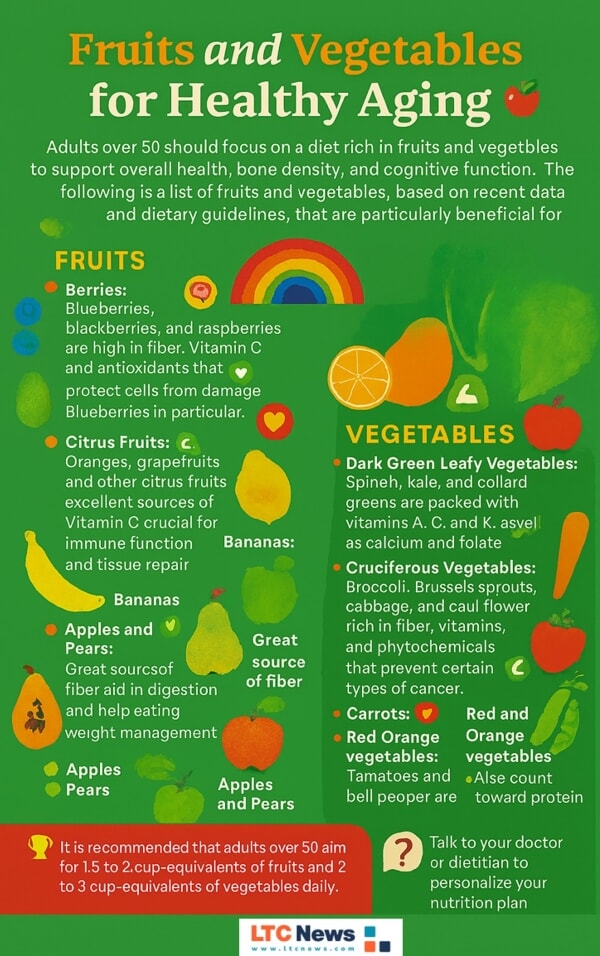Eat The Rainbow: How Colorful Produce Protects Your Health as You Age

Table of Contents
- Immune Strength from Fruits and Vegetables
- Optimizing Nutrient Absorption After 45
- Seasonal Produce: Rotating Nutrients Year-Round
- Daily Habits To Boost Your Produce Intake
- Storing Produce to Protect Nutrient Quality
- Filling Gaps Without Breaking Your Routine
- Nutrition And Aging: What To Eat Now to Protect Your Future
- Can Diet Help Prevent Dementia?
- If Your Loved One Already Has Dementia
- The Bottom Line: Color As Self-Defense
A colorful plate is a very good thing. As you start getting older, you’ve probably noticed your energy, immunity, or recovery times changing. The foods you choose now can shape how well you age. Adding color to your plate isn’t decoration. It’s biochemical diversity in action. Each hue in fruits and vegetables delivers distinct vitamins and plant compounds that work together to protect your health.
Crimson tomatoes funnel lycopene to your cells. Leafy greens deliver lutein to your eyes. Deep orange carrots push beta-carotene into circulation. Together, these pigments create an antioxidant synergy far more potent than that of isolated supplements.
According to a review in the American Journal of Clinical Nutrition, adults who eat a greater variety of fruits and vegetables show lower markers of oxidative stress—meaning their cells are better protected from damage.
Immune Strength from Fruits and Vegetables
Your immune system isn’t powered by wishful thinking. It runs on a steady supply of vitamins and phytonutrients:
- Vitamin C fuels phagocytes, your immune system’s cleanup crew.
- Vitamin A maintains epithelial barriers, your body’s first line of defense.
- Vitamin E diffuses free radicals.
- Vitamin K helps fine-tune inflammation.
Polyphenols—tiny plant chemicals abundant in berries, greens, and nuts—help cool overactive immune responses. Flavonoids and carotenoids help prevent low-level, chronic inflammation from escalating. Research from the University of Birmingham found that a higher intake of fruits and vegetables was associated with fewer days of cold symptoms in adults.
Optimizing Nutrient Absorption After 45
Some vitamins dissolve in water. Others need fat to sneak past your intestinal checkpoints. Vitamin C from peppers? Water-soluble. Vitamin A from kale? Fat-soluble. Pair leafy greens with avocado, nuts, or olive oil if you want the full nutrient payoff.
Supplements can help fill nutritional gaps if your diet falls short, but food should always come first. Not everyone eats as they should. For a streamlined, consistent delivery, products like fruits and veggies vitamins can bypass some of the absorption guesswork without removing plants from your plate.
Before adding any vitamin product, consult with your doctor or a registered dietitian, especially if you take prescription medications or have a chronic condition.

Seasonal Produce: Rotating Nutrients Year-Round
Your body benefits from eating with the calendar:
- Spring: Strawberries deliver vitamin C and polyphenols.
- Summer: Cantaloupe drops a payload of beta-carotene.
- Autumn: Squash and pumpkin carry vitamin A reserves.
- Winter: Citrus delivers antioxidants when you need them most.
Rolling with the seasons gives your body nutrient rotation that synthetic pills can’t replicate. Check farmers’ markets and grocery ads to see what’s peaking now.
Daily Habits To Boost Your Produce Intake
You don’t have to overhaul your life to eat more fruits and vegetables. Small changes work:
- Blend smoothies packed with spinach, berries, and yogurt.
- Keep prepped veggie packs in the fridge for quick snacks.
- Fortify grain bowls with chopped mango or blueberries.
- Pair cucumber slices with almond butter and sea salt for a fast, creative snack.
Storing Produce to Protect Nutrient Quality
Vitamins degrade quickly in heat, light, and air. Keep greens in the coldest part of the fridge, layered with paper towels to pull away moisture. Blanch and freeze broccoli at its peak if you can’t use it right away. Store fruit at ideal ripeness to lock in flavor and nutrients. Mishandled produce isn’t just limp—it’s robbed of the compounds you bought it for.
Filling Gaps Without Breaking Your Routine
Time crunch? Seasonal gaps? Taste fatigue? These aren’t excuses—they’re patterns. Frozen vegetables often preserve vitamins better than wilted “fresh” produce. Pre-washed salad greens make it nearly impossible to claim busy schedules as a barrier. Shop for discounts when produce is abundant, then freeze it to stretch your budget without sacrificing nutrients.
Nutrition And Aging: What To Eat Now to Protect Your Future
Getting the right balance of foods, vitamins, and minerals is essential to aging well and staying healthy. The right pattern—more plants, healthy fats, lean proteins, and fewer ultra-processed foods—can steady blood sugar, lower inflammation, and support a stronger heart and brain. Those gains matter for independence, recovery after illness, and how much help you may need later.
A produce-forward, Mediterranean-style diet (characterized by vegetables, beans, whole grains, nuts, olive oil, and fish) is associated with improved vascular and metabolic health—two key pillars of healthy aging and brain protection.
The World Health Organization recommends a healthy diet as part of a broader plan to reduce your risk of cognitive decline alongside exercise, tobacco avoidance, and control of blood pressure, cholesterol, and diabetes.
What this looks like day to day
- Fill half your plate with colorful vegetables and fruit; rotate berries and leafy greens.
- Choose olive oil, nuts, and fish for heart-healthy fats.
- Limit portions of added sugars and ultra-processed snacks.
- Aim for steady protein intake (e.g., fish, yogurt, eggs, tofu, beans) to help protect your muscles as you age.
- Vitamins and supplements can help you achieve your health and wellness goals.
Can Diet Help Prevent Dementia?
There’s encouraging—but not definitive—evidence for brain-healthy dietary patterns:
- MIND and Mediterranean patterns: Observational data link higher adherence with reduced Alzheimer’s risk and slower cognitive decline. These studies do not prove cause and effect but suggest meaningful benefit.
- Lifestyle risk factors: The Lancet Commission estimates a large share of dementia cases may be preventable by addressing modifiable risks (hearing loss, hypertension, diabetes, inactivity, and more). Diet is not singled out as a stand-alone “risk factor,” but it supports control of the vascular and metabolic risks that are on the list.
- Omega-3s: Observational research suggests possible protection, but randomized trials of omega-3 supplements show inconsistent or no clear preventive effect. Food sources (fatty fish, walnuts) are still sensible within a healthy pattern.
Research teams at Rush University developed the MIND diet (Mediterranean-DASH Intervention for Neurodegenerative Delay). In cohort studies, higher MIND adherence was associated with a substantially lower risk of Alzheimer’s disease and slower cognitive decline.
The research showed that people who adhered even moderately to the MIND diet had a reduction in their risk for Alzheimer’s disease.
Bottom line for prevention: You can’t “eat away” all dementia risk, but a heart-healthy, plant-forward pattern supports the very systems—blood vessels, metabolism, inflammation control—that protect the brain.
If Your Loved One Already Has Dementia
Nutrition still helps—not to reverse the disease, but to protect weight, strength, immunity, and quality of life.
- Preventing weight loss and frailty: People living with dementia often lose weight and develop malnutrition. Research suggests that high-calorie, high-protein oral nutrition supplements can enhance intake, weight, muscle mass, and nutritional markers; however, they rarely improve cognitive function itself. Work with a clinician or dietitian to tailor choices and address swallowing or texture needs.
- Daily strategies that make a difference: Small, frequent meals; finger foods if utensils are a barrier; calm eating spaces; familiar flavors; and adequate hydration. Consider fortified smoothies (such as fruit, yogurt, and nut butter) when your appetite is low.
You won’t change the diagnosis with food, but you can absolutely change the day—more energy, fewer infections, fewer hospital trips.
The Bottom Line: Color As Self-Defense
Consistent produce intake wires your system for higher energy, efficient immunity, and long-term vitality. Build a loop: plan your produce, prep it early, rotate by season, store it right, and repeat.
Continue to challenge your palate with new fruits and vegetables each week. It’s not variety for variety’s sake—it’s a quiet form of self-defense that helps you stay strong and independent well into older age.
Always consult a qualified health care professional about your personal dietary needs or before making changes to your nutrition or supplement regimen.
Aging has challenges, and while there are many things you can do to improve your quality of life as you get older, you can't avoid the consequences aging and future long-term care will have on your family and friends. Utilize the tools and resources available on LTC News to gain a deeper understanding of long-term care planning.


